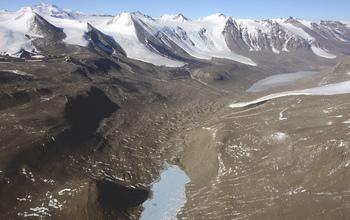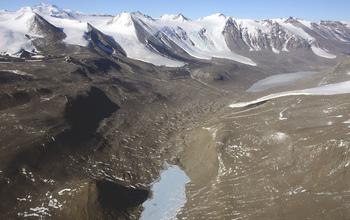
Credit: Peter Rejcek
An abnormal season of intense glacial melt in 2002 triggered multiple distinct changes in the physical and biological characteristics of Antarctica's McMurdo Dry Valleys over the ensuing decade, new research funded by the National Science Foundation (NSF) shows.
The findings suggest that abrupt, short-lived climate events can cause long-term alterations in polar regions that unfold over the span of several years and subsequently change the overall trajectory of an ecosystem.
The new research appears today in the journal Nature Ecology and Evolution.
Paul Cutler, the NSF program officer for the two Long-Term Ecological Research (LTER) sites in Antarctica, noted that these results underscore the value of gathering data over decades.
"The natural world operates in non-linear ways and on many different time scales, from daily cycles to processes that take centuries," said Cutler. "LTERs are instrumental in measuring and deciphering these complexities in order to inform basic understanding of ecosystem functioning and to refine predictions of the future of critical ecosystems, particularly in areas like the Dry Valleys, which maintain an ancient, but potentially delicate ecological balance."
The McMurdo Dry Valleys are the largest ice-free region of Antarctica and are considered a polar desert environment due to their low humidity and scarce precipitation. Now in its 25th year, NSF's McMurdo Dry Valleys Long-Term Ecological Research (LTER) project has provided a continuous multi-decade record of atmospheric and ecological data at the research site.
Between 1987 and 2000, the Dry Valleys experienced a period of cooling, during which mean summer temperatures steadily declined while solar radiation gradually increased. The trend resulted in expected changes to most biological variables, including decreased streamflow and increased thickness of permanent ice cover on lakes.
In 2002, however, the Dry Valleys experienced an abnormally warm and sunny summer season, triggering the greatest amount of glacial meltwater since 1969. The event prompted numerous changes in the lakes, streams and soils of the region over the following decade.
"This flood year was the pivot point," said Michael Gooseff, a fellow at the University of Colorado Boulder's Institute of Arctic and Alpine Research (INSTAAR) and the lead investigator for the Dry Valleys LTER project. "Prior to that, all physical and biological indicators had been moving in the same direction."
Instead of a tightly correlated change, however, biological responses to the 2002 season varied and, in some cases, lagged behind by years. For example, the researchers found that one previously declining dominant soil species increased slowly following the flood year. Another species responded more positively to the moisture pulse and saw population increases carry over into subsequent summers.
"Long-term records are essential to understand how and when communities of organisms might respond together or as individual species when facing abrupt changes in their environment," said Ross Virginia, director of the Institute of Arctic Studies at Dartmouth College and a co-author of the study. "As climate changes in the Dry Valleys, these kinds of biotic responses and interactions will shape its future biodiversity."
The findings suggest that significant transformations of Antarctic ecosystems are underway now and will continue to be affected by future climate events.
"A single extreme melt season led to an asynchronous pattern," said Gooseff, who is also an associate professor in the university's Department of Civil, Environmental and Architectural Engineering. "It may be the abrupt, short-lived events that occur in response to climate change that cause long-term changes to physical and biological aspects of polar ecosystems."
###
Co-authors of the new research include Diane McKnight and Eric Sokol of University of Colorado Boulder and INSTAAR; John Barrett of Virginia Tech University; Byron Adams of Brigham Young University; Peter Doran of Louisiana State University; Andrew Fountain of Portland State University; William Lyons of Ohio State University; John Priscu of Montana State University; Cristina Takacs-Vesbach of the University of New Mexico; Martijn Vandegehuchte and Diana Wall of Colorado State University.
Media Contact
Peter West
[email protected]
@NSF
http://www.nsf.gov





